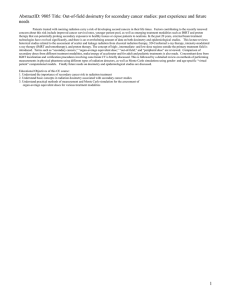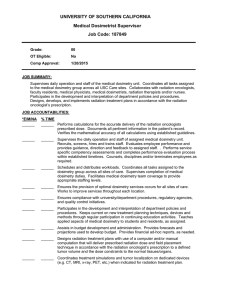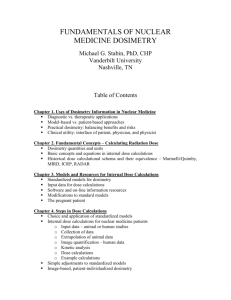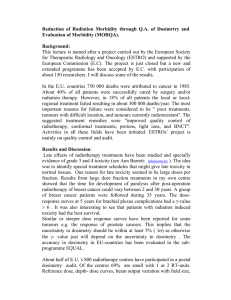Medical Dosimetry Certification Board (MDCB) Perspective on “Teaching Physics to Dosimetrist”
advertisement
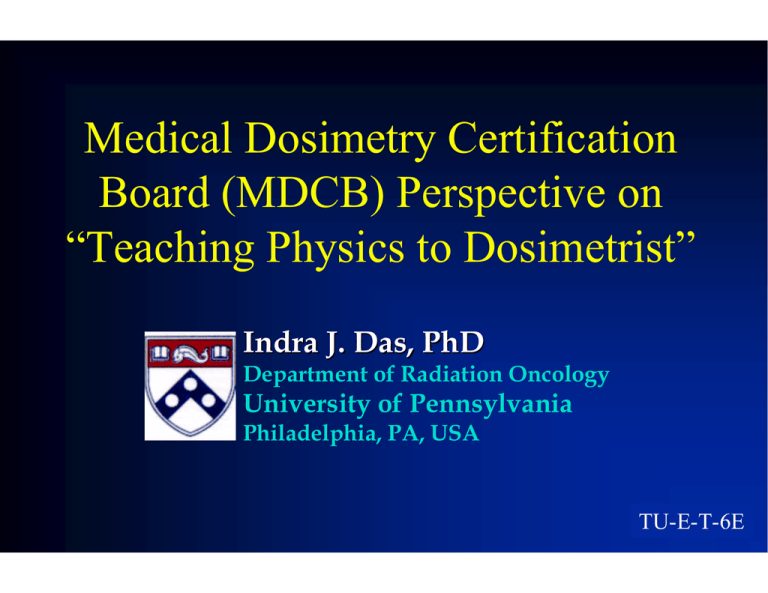
Medical Dosimetry Certification Board (MDCB) Perspective on “Teaching Physics to Dosimetrist” Indra J. Das, PhD Department of Radiation Oncology University of Pennsylvania Philadelphia, PA, USA ID/AAPM-05 TU-E-T-6E Acknowledgments Many thanks to the members of the MDCB board but special thanks to Bud Baker who provided the historic background of the MDCB ID/AAPM-05 Historical Perspective In early 1980, American Association of Medical Dosimetrists (AAMD) formed a Task Group called ‘Certification Committee’ to look into the feasibility of evaluating dosimetrist credential. A private company ‘Credentialing Services Inc, (CSI)’ was contracted to provide psychometric and logistical services. Medical Dosimetry Certification Board, MDCB was formed with logo ID/AAPM-05 Early Examination A group of Subject Matter Experts was appointed to write questions for the exam item bank under the direction of CSI, managed by Dr Jim Hecht. These questions became the foundation of the item bank and were expanded in number through exam writing workshops over a period of 3 years. ID/AAPM-05 First Examination In 1988 the MDCB was incorporated in the state of Maine. In same year, the first exam, was offered at a single location in Calgary, Canada during the AAMD annual meeting. MDCB examination was taken by 136 eligible candidates . 85% candidates passed the MDCB exam. ID/AAPM-05 Examination Pattern Typically there are 155 questions K type Multiple choice Matching True & False Passing raw scores had been traditionally 60-66%. There are a few exceptions some year. ID/AAPM-05 Question Analysis Since the 1988 first exam, detailed psychometric statistics for each question in the item bank as well as overall exam performance has been maintained. As the item bank grew, questions were either discarded or refined so the overall exam difficulty could be predicted and defended through statistical analysis. ID/AAPM-05 Examination Acceptability After the first exam in 1988, the exam has been offered in multiple locations (20-30) in the US and Canada distributed in major cities. Since 2004, the MDCB exam is being offered in South Korea. Various other countries in Pacific Rim, Europe and Latin America has shown interest in hosting MDCB examination. ID/AAPM-05 MDCB Board The MDCB board consists of 11 volunteer members. The tenure of each member is 5 years. It consists of members from every radiation related societies: Five At Large Members of the board are certified medical dosimetrist (CMD). One member each from ASRT, AAMD, AAPM, ACMP, ACR and ASTRO. ID/AAPM-05 Examinations In 1991 a continuing education requirement was tied to the CMD credential renewal. In 1994 first Practice Analysis Study was conducted by CSI to incorporate the growing trends in technology for dosimetrists to reflect exam content specifications directly tied to the results. ID/AAPM-05 Recent Changes In 2000-01, The Scope of Practice in Medical Dosimetry was approved by the MDCB Board. In 2003, managerial services of the MDCB was given to the AMC, Albuquerque, NM for a a 3 year contract. Thomson Prometric becomes the exam administrator in 2004. From Aug 2005, the MDCB will be managed by a management firm ‘Association Headquarters Inc’, AH, Mount Laurel NJ who will provide member services automated through web. ID/AAPM-05 Medical Dosimetry Programs There are 75 JRCERT accredited therapist programs, some of them provide dosimetry training There are only 5 formal dosimetry programs and a handful schools (20) that provide medical dosimetry program JRCERT is getting involved in accreditation of the medical dosimetry program. ID/AAPM-05 Changes in Examination In 2004, Thomson Prometric (then Chauncey Group International) conducted a web based Practice Analysis Exam content specifications. Current examinations are based on the 2004 practice analysis that represent the current practices of Medical Dosimetry. ID/AAPM-05 Training & education Typically most formal program gives BS degree Some programs offer MS degree Certificate programs Education and contents are variable 2 wks to 4 years ID/AAPM-05 ID/AAPM-05 Schools 2 weeks to 4 years First web based training program initiated under guidance of Dr Art Boyer at Stanford University. Due to demand of dosimetrist, lots of school have opened in recent years Education and training varies significantly ID/AAPM-05 Exam Contents & Necessary Physics Education Radiation Physics Dose Calculation Methods Treatment Planning Localization Brachytherapy Quality Assurance Professional responsibilities Computers & Computer Networking 20% 25% 30% 8% 5% 3% 2% 5% ID/AAPM-05 Radiation Physics (20%) Radioactivity Production of x-rays Interaction of radiation with matter Photon Electrons Treatment unit characteristics Treatment planning computers Radiation measurements ID/AAPM-05 Dose Calculation Methods (25%) Applied mathematics (geometry, trigonometry) External beam calculation Beam modifying devices (wedge, bolus, blocks, etc) Irregular Field calculation Special calculation (off-axis, gap, entrance, exit etc) Tissue inhomogeneity Electron beam calculation Interaction of radiation with matter ID/AAPM-05 Treatment Planning (30%) Isodose curve parameters Isodose distribution Electron beam dose distribution Clinical Oncology Radiobiology Dose volume histogram IMRT Dose and fractionation ID/AAPM-05 Localization (8%) Acquisition of patient data Immobilization & Positioning Treatment devices (bite block, breast board etc) Treatment simulations Imaging (CT, MRI, PET) CT-simulation, DRR, DCR etc Image registration (fusion) ID/AAPM-05 Brachytherapy (5%) Radioactive source characteristics Dose distribution Source localization HDR/LDR ID/AAPM-05 Radiation Protection (2%) Maximum permissible dose NCRP, ICRP recommendations Radiation monitoring Personnel Patients Protection through Time Distance Shielding ID/AAPM-05 Quality Assurance (3%) Equipments Treatment Machines Simulators Treatment planning computer Clinical Aspects Chart reviews Film reviews Plan checks ID/AAPM-05 Professional Responsibilities (2%) MDCB code of ethics Standard Precautions CPR Responsible fiscal practices (billing) HIPPA & Fed regulation ID/AAPM-05 Computers & Networks (5%) Data importing & exporting System management Tape backup Routine maintenance Up/down loading Algorithms TPS software Calculations ID/AAPM-05 Text Books Physics of Radiation Therapy – Treatment Planning Task Group Reports CT-simulation Faiz M Khan G. Bentel AAPM, NCRP Coia et al ID/AAPM-05 ID/AAPM-05
